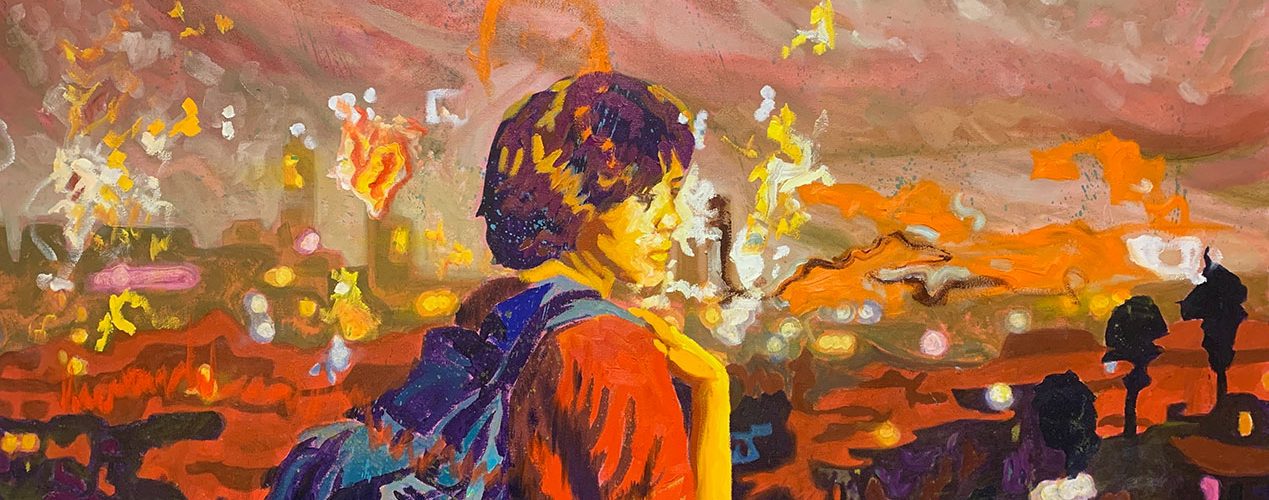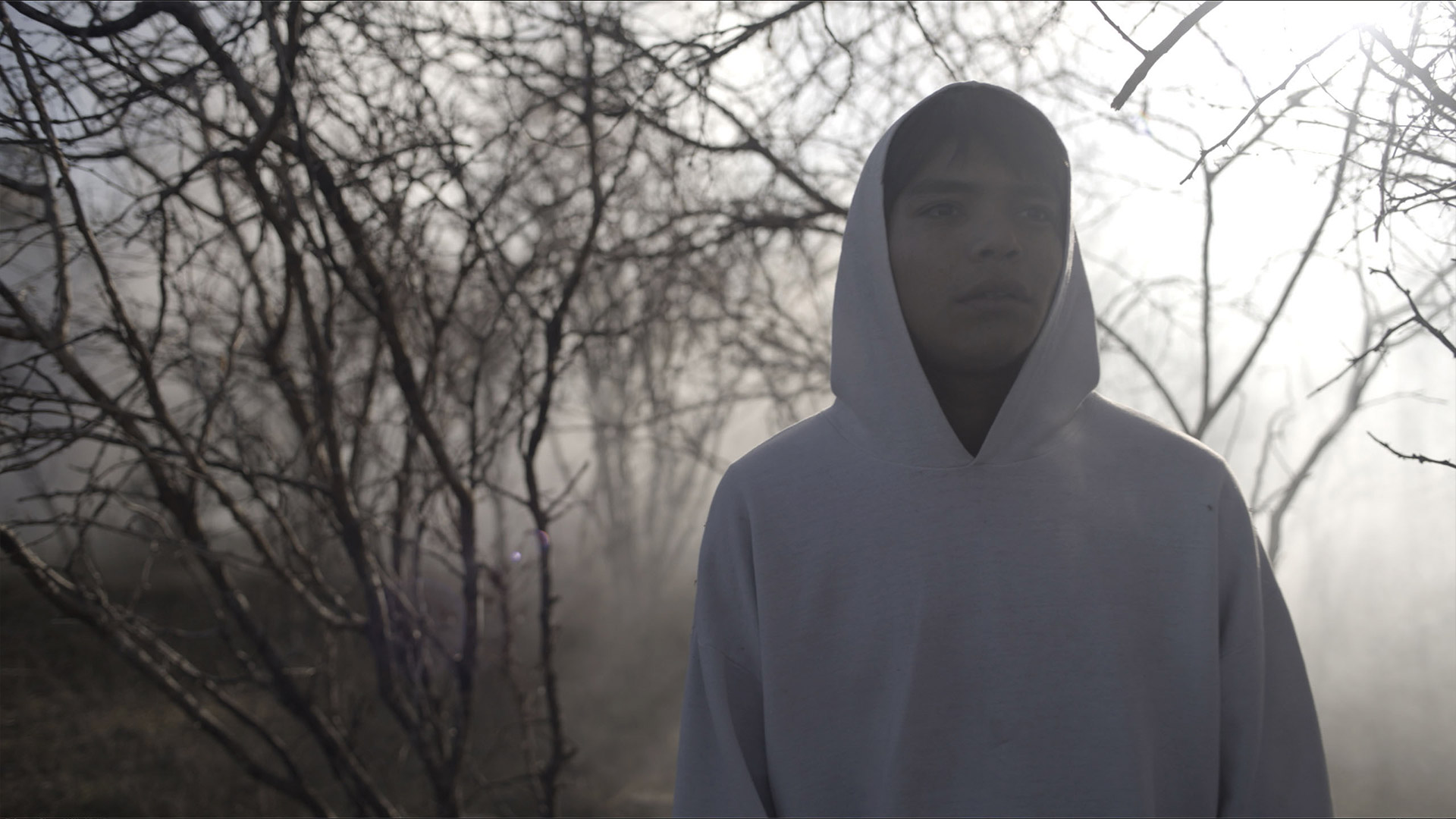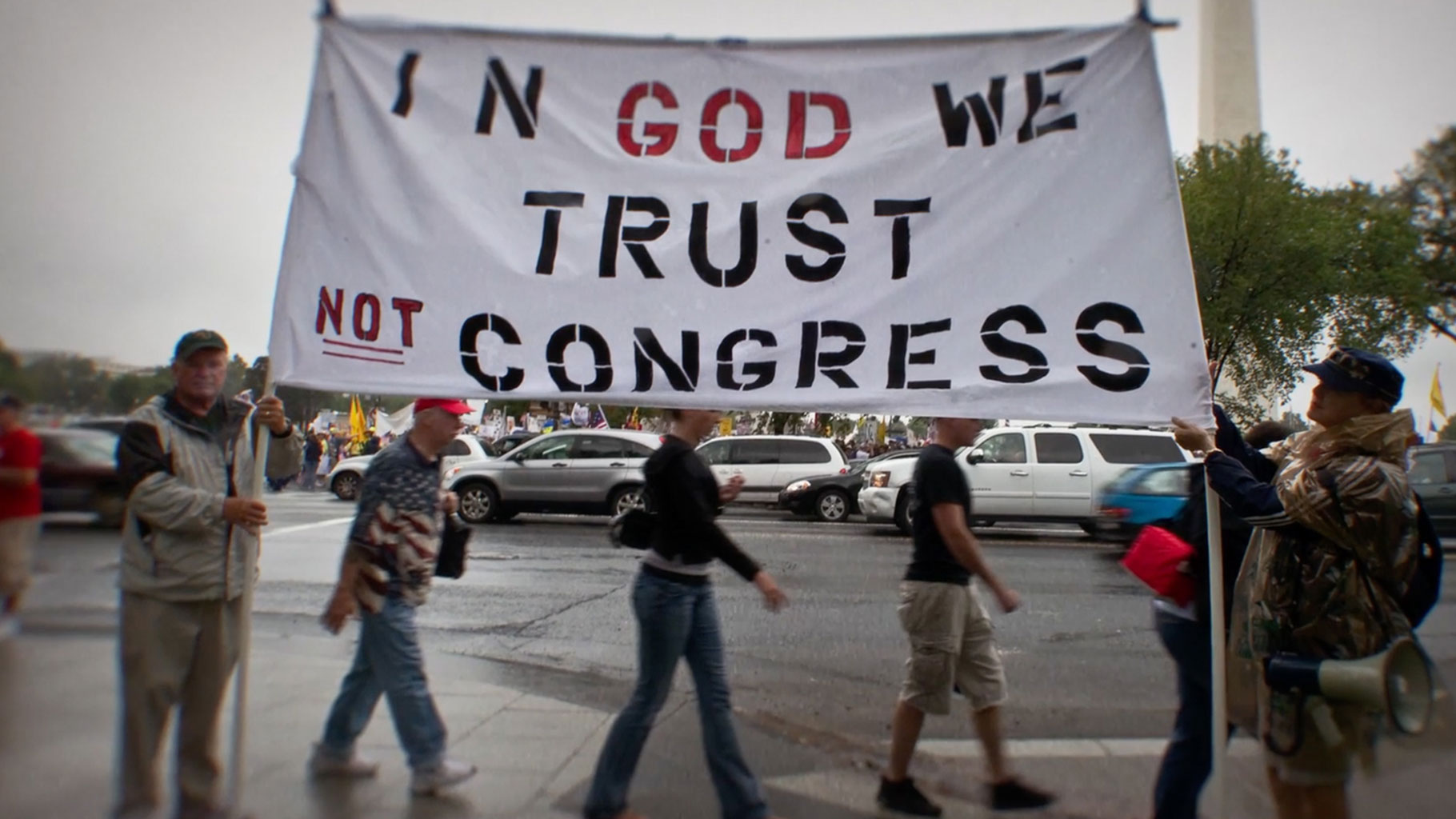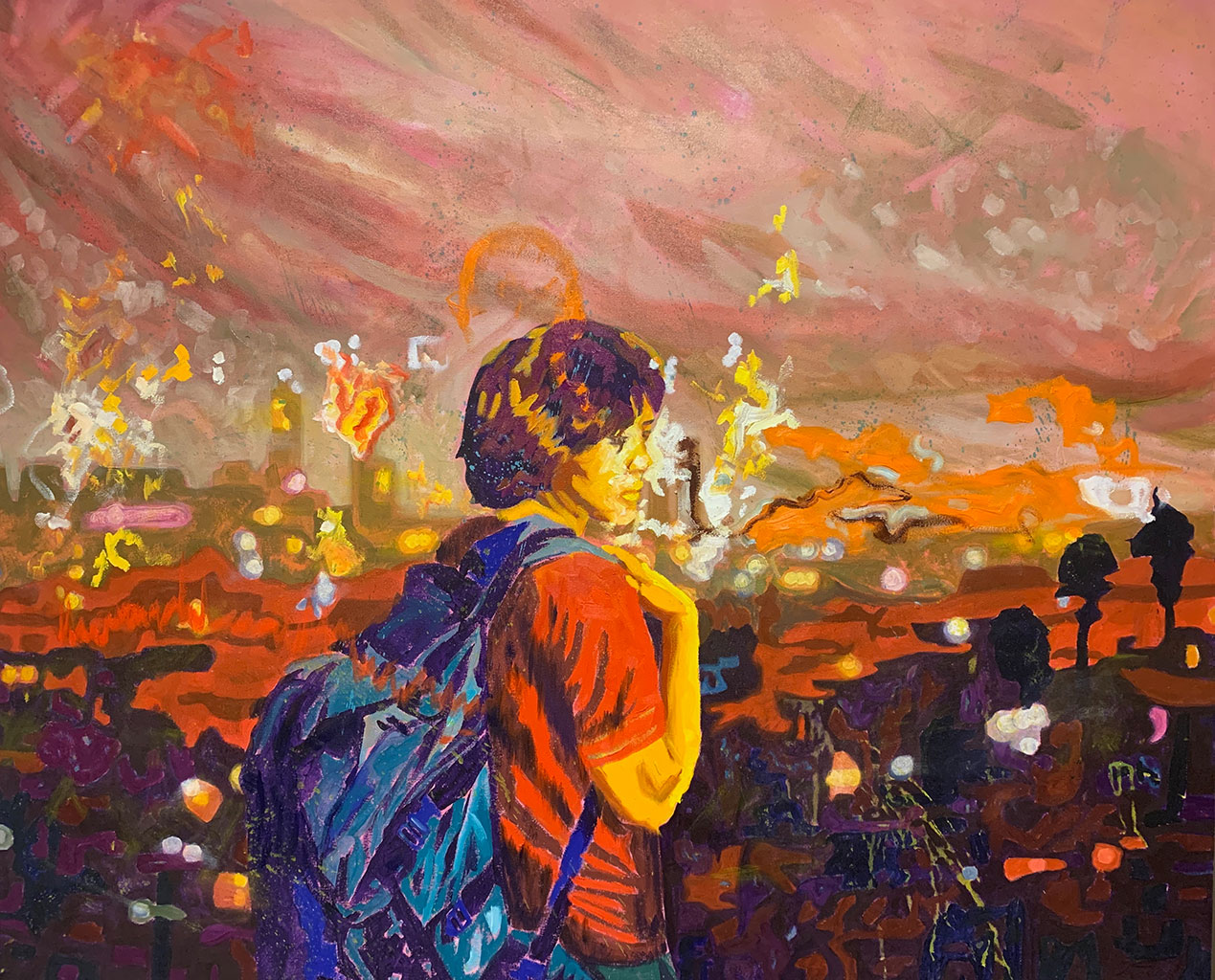
Miles in the Smog, 51″ x 42″, acrylic and oil, 2022
“I have a lot of artwork right now that’s about a climate apocalypse and different climate disasters,” explains Kawakami, who is based in Bellingham, Washington, near the Canadian border. “[I’m] just responding to things that I’ve witnessed in my community.”
Their current focus is driven by the exploration of “apocalypse” as it appears in a range of different locations and experiences. It first emerged in 2020, when Kawakami began creating paintings of masked people navigating the start of the COVID-19 pandemic.
The painting Teenage Apocalypse (2021), was among the first. Originally named Downtown Disease, it depicts a night scene in downtown Bellingham, where three masked youths and a distant shadowed figure stand in a quiet alley. The scene is mostly unassuming – an ordinary pedestrian street with zigzagging lights strung overhead, a vibrant mural along one wall, and graffitied garbage bins – yet the looming shadowed buildings that disappear into darkness and tired distant gazes from the characters bring a quality of unsettledness to the piece.
It was through these initial paintings that Kawakami began in earnest to explore and document the end of the world in their art practice.
“It is sort of a slow and long apocalypse that we’re experiencing and that I’m trying to depict,” explains Kawakami. “This is the point where everyone is realizing that this is screwed up, and we’re not gonna have life as it normally was.”
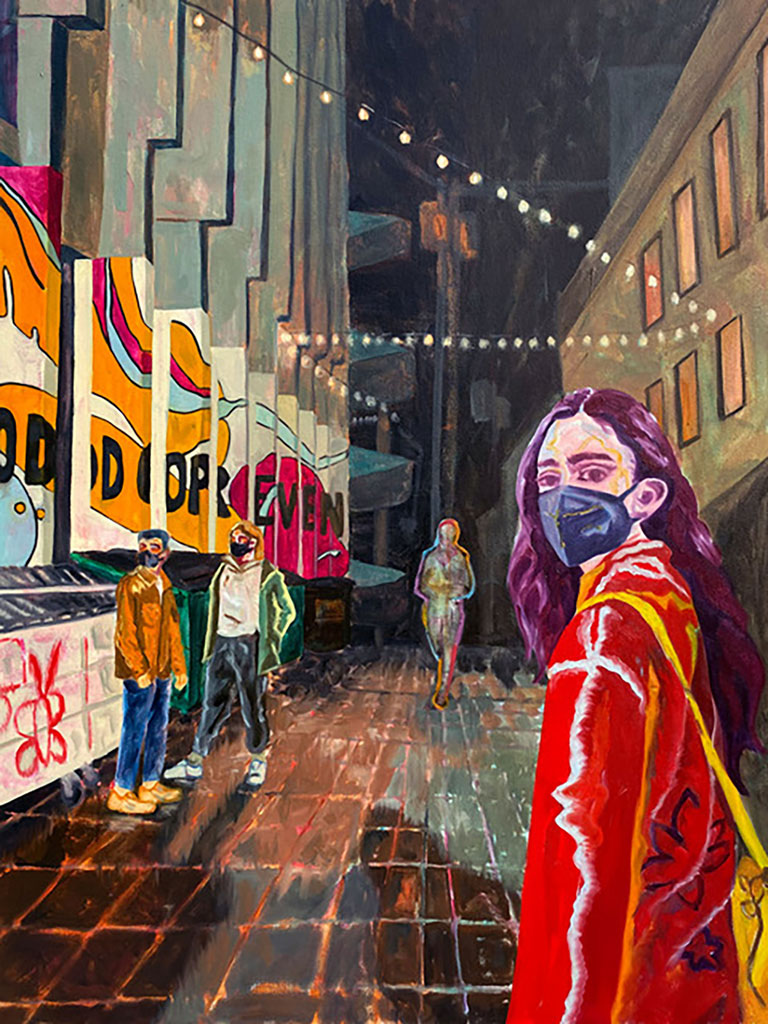
Teenage Apocalypse, 60″ x 56″, Oil and acrylic on canvas, 2021
Climate Change as Apocalypse
While they were focused on depicting humans navigating the global pandemic, Kawakami explains that climate events have become “more pressing in [their] day-to-day life than COVID-19.” Now, their art is “more about these humans trying to interact with very dangerous environments.”
During the late fall of 2021, Bellingham experienced massive flooding. Kawakami recounts how businesses were shut down for upwards of a month due to water damage, and how it was impossible for residents to drive anywhere.
During that period, they realized that this would be the next apocalyptic experience to paint. They searched for images of the floods online, finding drone footage and photographs of familiar landmarks transformed by the record rainfall.
In Kenworth On Iowa (2021), grey-clouded skies kiss a treeline of vibrant oranges and dark greens. Where there should be a street, there is instead water reflecting the overcast sky and surrounding buildings. No humans are present here, but the foreground is full of life. Two young bucks stand on the water’s surface; where a shadowy reflection would be, there is a striking red silhouette instead. There are other creatures as well — many with similar peculiar red mirrored shadows: a pair of ducks, a swimming raccoon, and a bird of prey sitting atop the traffic signal set to stop.
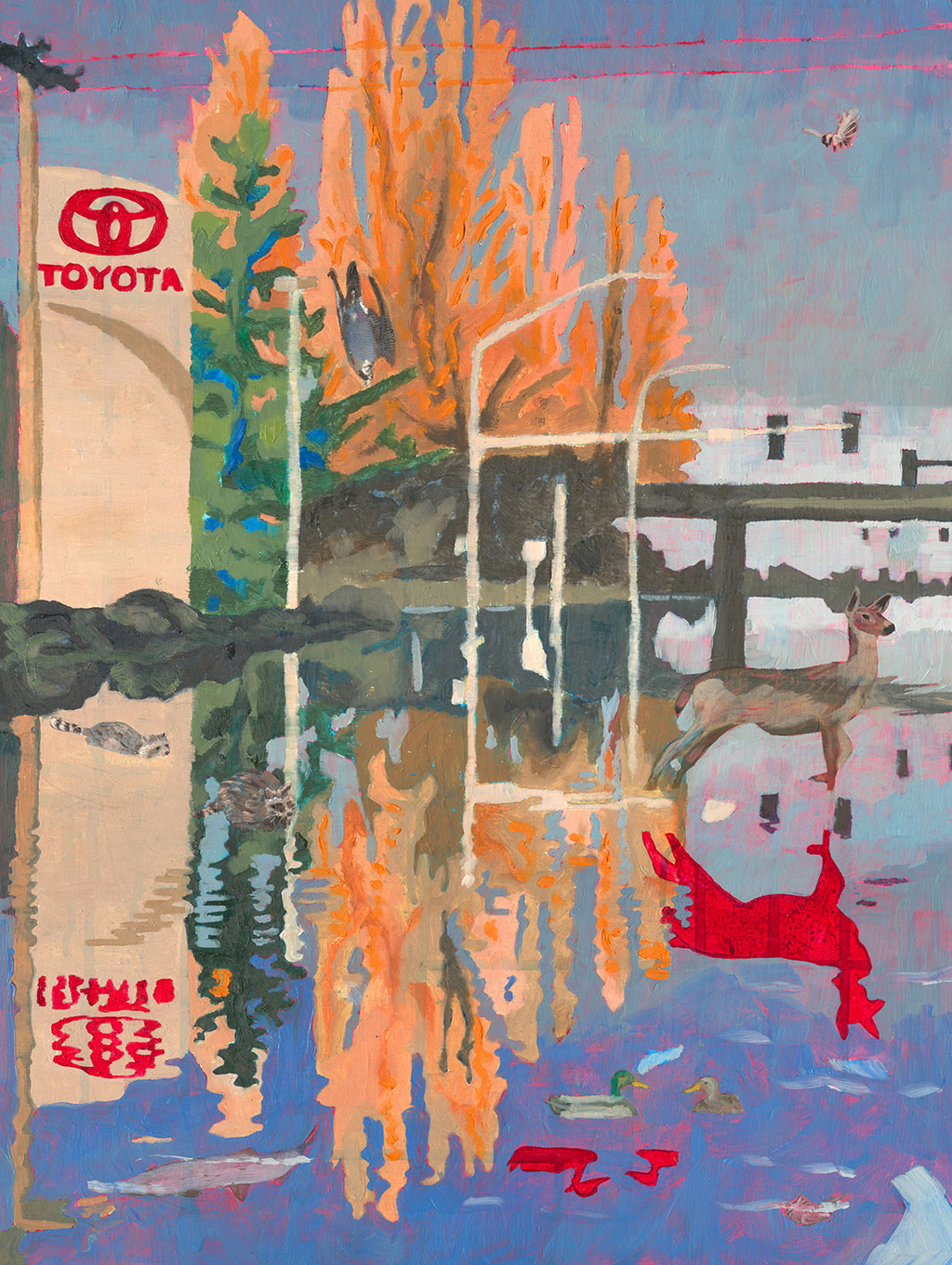
Toyota on Iowa, 24″ x 18″, Oil, acrylic, and acrylic gel photo transfer on wood, 2021
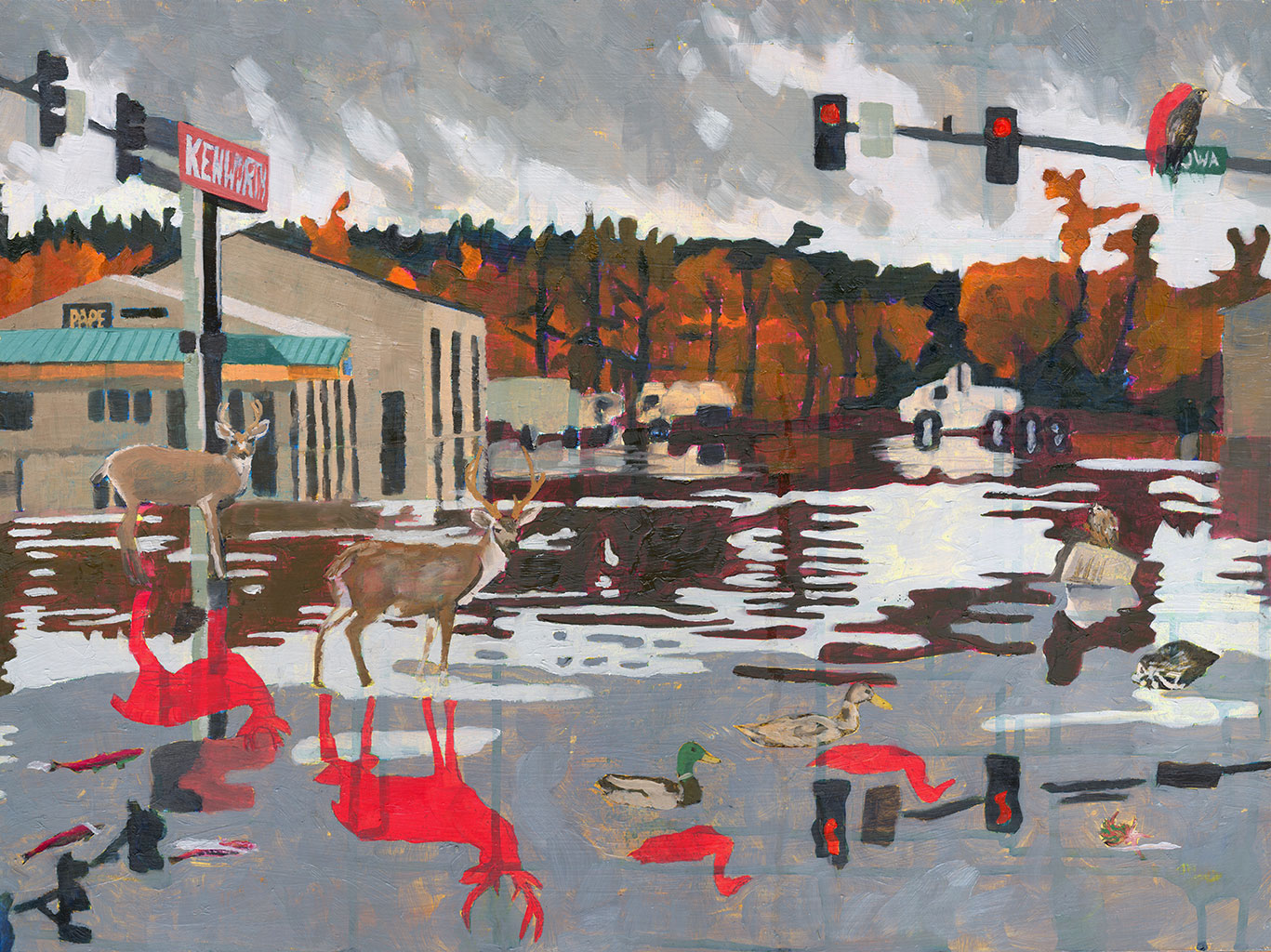
Kenworth on Iowa, 18″ x 24″, Oil, acrylic, and acrylic gel photo transfer on wood, 2021
In Electric Apocalypse, the third painting in the Bellingham flood trilogy, Kawakami begins to incorporate an explosion of patterns through repeating imagery and colors along with paint drips that distort the painting into a paradox of unfamiliar familiarity. The background pictures a 76 gasoline station; high water levels consume whatever road that had once been visible. A magenta-colored buck walks atop the water’s surface with his reflection mirrored beneath. A wolf is placed just a few paces away with a bright purple version offset over its left shoulder.
These vibrant offsets fragment the perceived normality of the painting. Kawakami describes how they intentionally began “depicting different moments of time in the same image” by using repeating elements and subjects that would essentially “break the world into something unfamiliar.” Their intention in doing so was to elicit the feeling that the subjects are existing in a world that is a few evolutionary cycles ahead of the current time.
The rest of the Electric Apocalypse is also alive with similar neon chaos: the 76 logo sign is fragmented and repeated several times throughout the sky, materializing and rippling between a swarm of colorful bird silhouettes caught in midflight. Between the glitched-out animals and structures are crackles of the pink acrylic undercoat which gives the painting a radioactive quality.
“It’s based in reality, but it’s a little futuristic – a little bit evolved or condensed into something that’s more intense, more unignorable,” Kawakami explains. “[In real life,] we’re kind of able to just put [climate change] on the back burner and do our little daily life things like make our paintings and go to work. But in this world, it’s progressed so far that it’s unavoidable.”
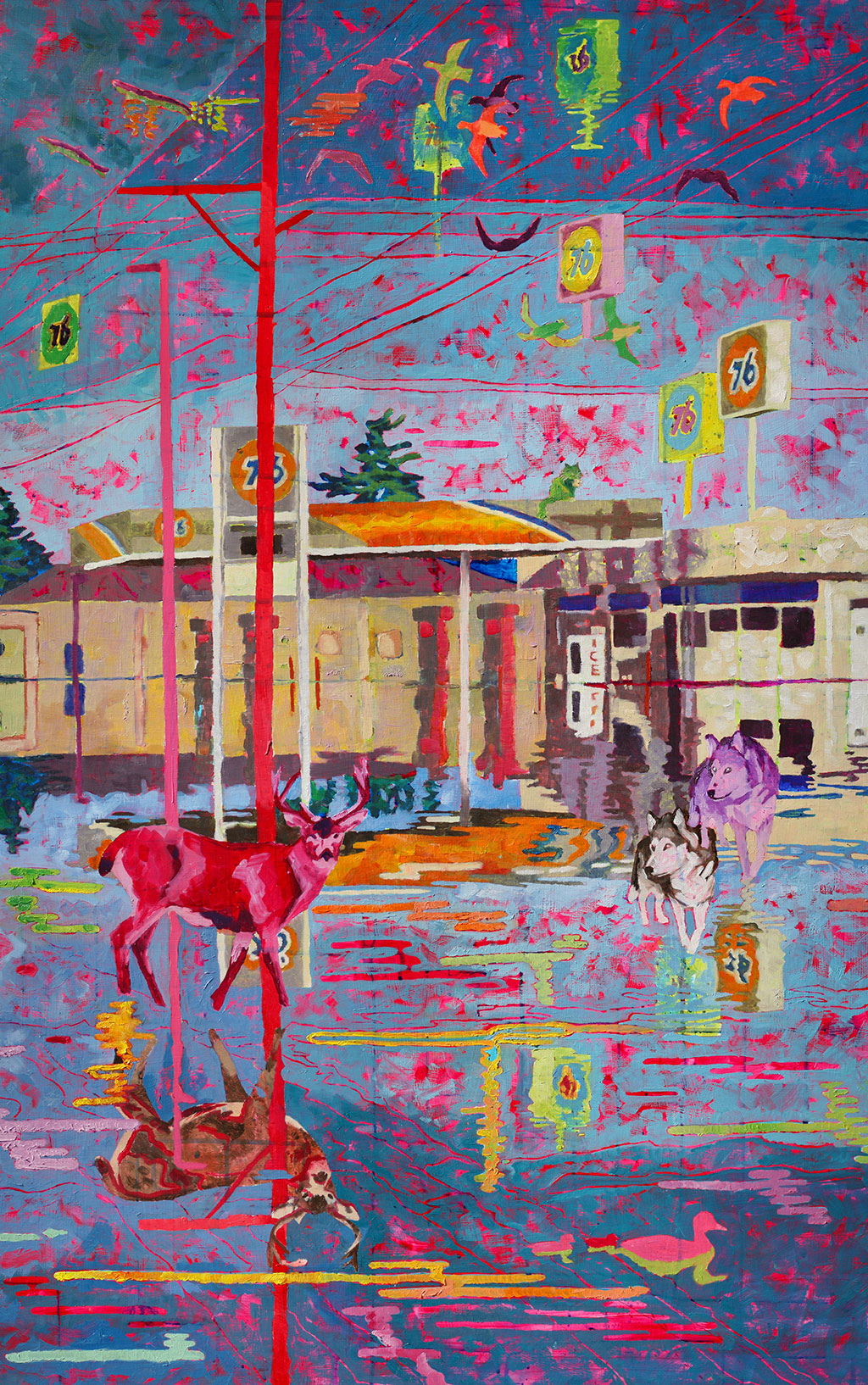
Electric Apocalypse, 48″ x 30″, Oil and acrylic on wood, 2021
For Kawakami, this trilogy holds “a more optimistic feeling” than some of the other pieces they paint because they consider it “a later stage of apocalypse where there [isn’t] as much active conflict.” The flood paintings are an exploration of nature reclaiming urban structures and depicting a changing ecosystem.
Paintings with more active conflict include some of their recent work, such as Miles in the Smog, where a character exists within “really fiery landscapes.” Yet, even in these scenes, Kawakami believes that “the tenacity of people and the[ir] perseverance feels really hopeful,” despite the circumstances.
“There [can be] a lot of beauty… [in] something that’s being destroyed,” says Kawakami, who hopes to explore related themes in her next works, related to “erosion and architecture and infrastructure being broken down and turning back into nature.”
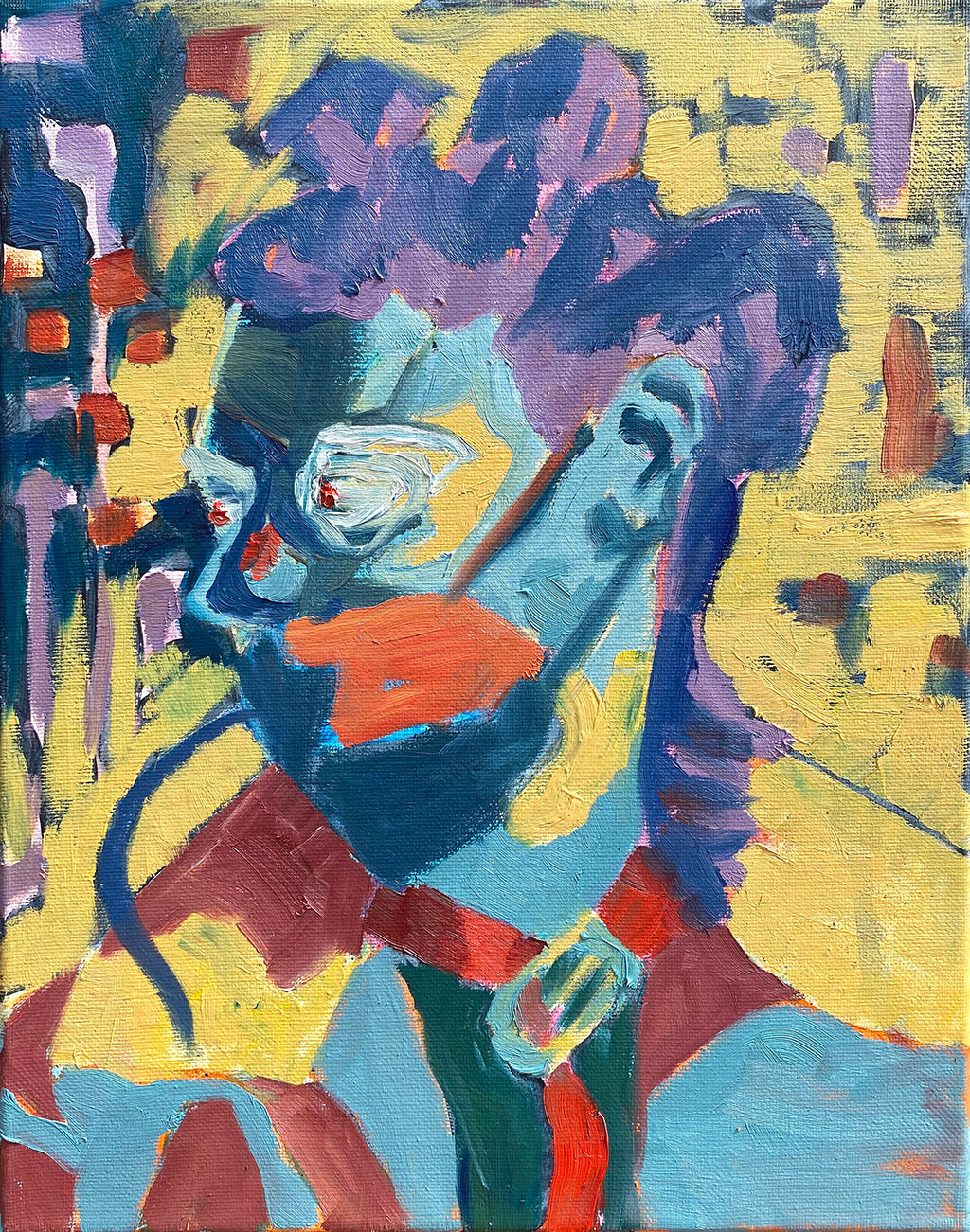
Masked Self, 14″ x 10″, oil and acrylic on canvas, 2020
A Multitude of Definitions of “Apocalypse”
Kawakami has since encountered several perspectives on the apocalypse prevalent in different cultures and lived experiences. They note one particularly insightful conversation between them and their friend Iris whilst they were studying in Auvillar, France. Their conversation explored the multitude of global experiences and, in particular, noted that “to certain groups of people, like Native Americans and Indigenous people, the apocalypse has long already begun.”
Kawakami has continued to reflect on the reality that for many people, “their world has already been totally decimated and destroyed,” and that the devastation and ravages of colonization are indeed apocalyptic.
During Kawakami’s art intensive in France, they also encountered a comedic video art piece about a “queer apocalypse” that was perceived by a straight community “as the end of the world.”
For Kawakami, having a diverse set of queer characters that appear in their apocalypse art is valuable beyond measure. In some ways, having these characters “glorified or memorialized in [a] piece of media that [one] can fixate on and obsess over” nurtures both their younger self and the queer community at large.
“I’ve thought a lot about dystopian media that I would read as a teen, like The Hunger Games or Divergent,” says Kawakami, describing them as books that would “satisfy this feeling of teen angst.” They hope to elicit the same satisfaction in their artwork and are motivated by the knowledge that media with non-binary and queer leads can have a profound impact on youth who desire and deserve to be visible and feel a sense of belonging in the world.
“I don’t want to have this be an all-white apocalypse,” says Kawakami. “I want it to be… [about] queer people and people of color.” In their imagining of the apocalypse, it is “those people who are going to have the skills to persevere.”
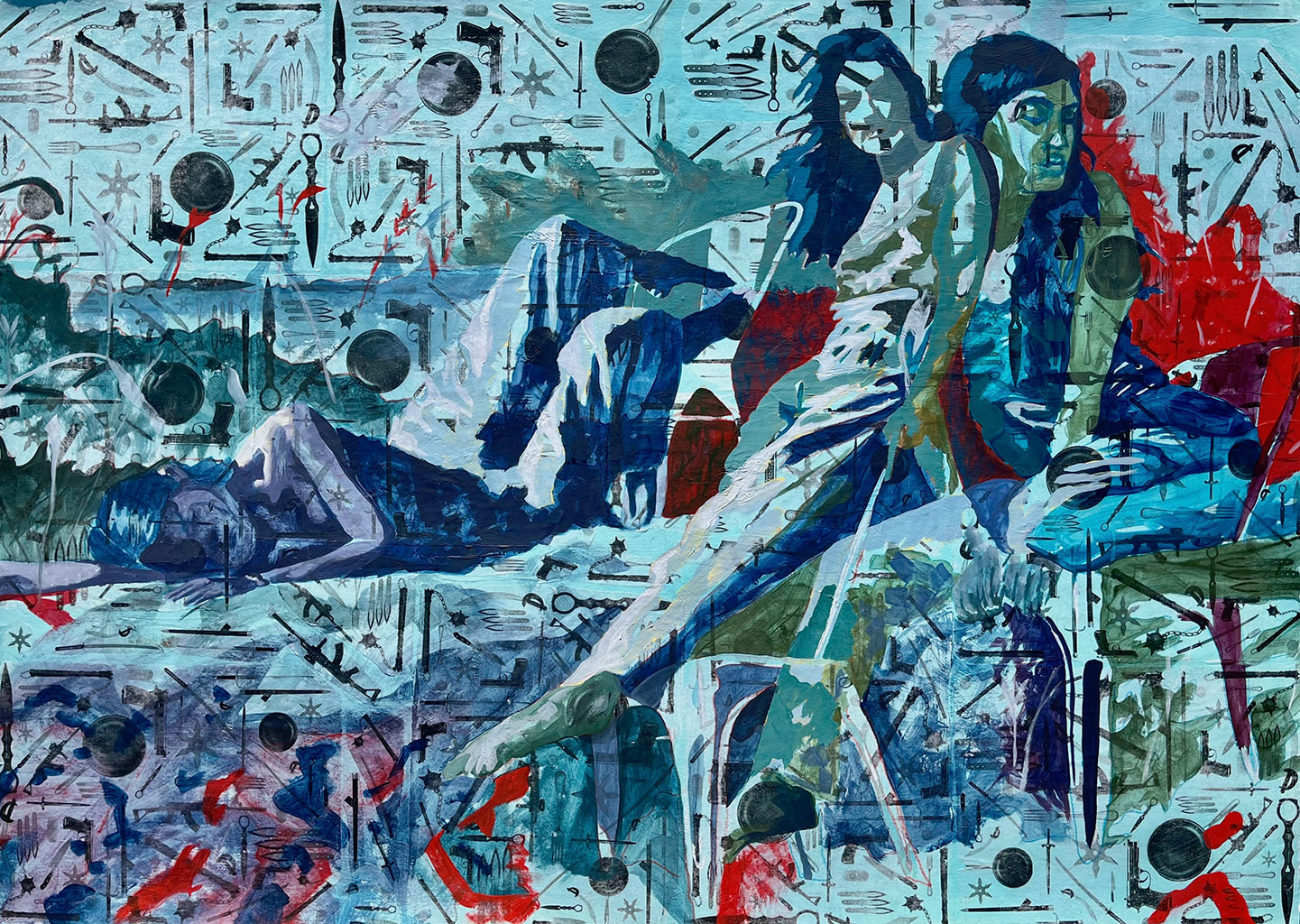
Ripped, Heaving, 30″ x 41″, acrylic and acrylic gel photo transfer on paper, 2022
Processing within the Process
Kawakami started developing their current creative workflow two years ago, in conjunction with the emergence of the apocalypse theme. Initially, they begin by projecting and sketching a reference image onto a large canvas, then laying down a bright acrylic underpainting before adding layers of oil paint on top.
“It takes me probably three days of work to even get to the oil painting [stage] – and that’s if I worked all day for three days…” says Kawakami. When they do get to adding oil paint on top, they share that they will intentionally leave “little gaps” for the original vibrant acrylic underpainting to show through, such as previously described in Electric Apocalypse.
After coming across Nigerian-American artist Njideka Akunyili Crosby’s work, Kawakami was inspired to begin adding acrylic photo transfers into their already labor-intensive process. They were initially drawn to this technique in Crosby’s work because of how the placement of ink from the photo transfers could be used to resemble highlights or shadows. As Kawakami began incorporating it into their paintings, they noticed how the photo transfers allow them to layer meanings and contrasting moods within their paintings. The eclectic vibe that the transfers provide also allows them the flexibility to “make decisions later on when paint[ing] about what [they] want to push back or emphasize.”
The acrylic photo transfer process is a laborious technique, but Kawakami explains that the long process does hold significance thematically. The act of having so many different layers and images that get covered up to be “brought back through” in the end highlights that what was once hidden can become instrumental and “important in the final” painting.
A Thought Bubble of Technology and the Apocalypse
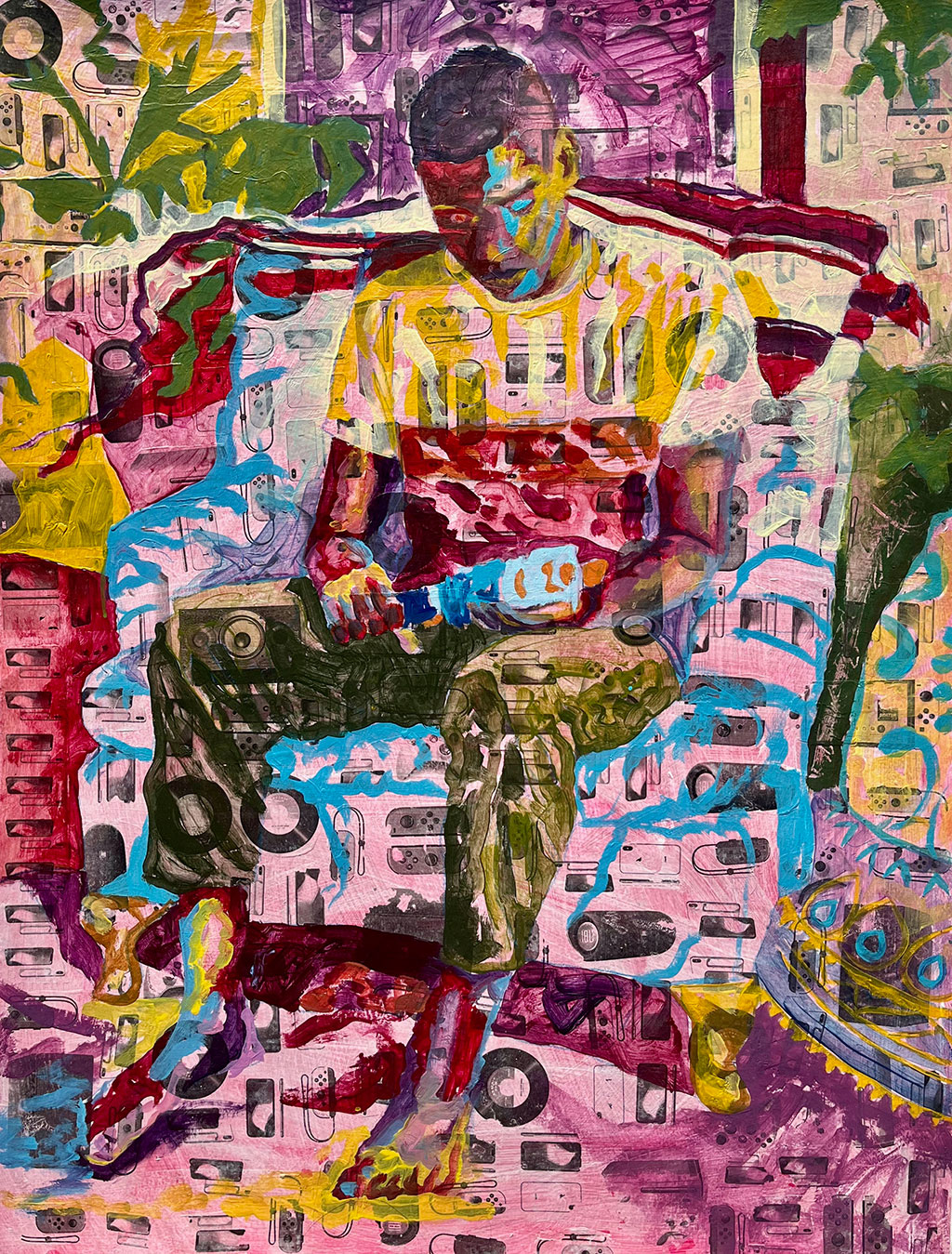
Quinten’s Introspective, 22.5″ x 30″, acrylic and acrylic gel photo transfer on paper, 2022
In Quinten’s Introspective (2022) and Quinten’s Outrospective (2022), Kawakami took a different approach to apocalypse analysis. Instead of focusing on environments of climate disaster, they instead depicted a close-up scene of their roommate, Quinten, sitting on an armchair, holding what looks like a Nerf gun in his lap. Acrylic photo transfers that make up the background are pictures of “all of the technologies that he uses: his iPhone, the Switch, an Xbox, speakers…”
“It’s interesting to think about people’s different interpretations of technology and apocalypse,” shares Kawakami, who initially perceived it as apocalyptic to no longer have access to all these technologies. Yet, during a critique session held within their Art Studio BFA cohort, others shared that they thought that “the apocalypse is having technologies too present.”
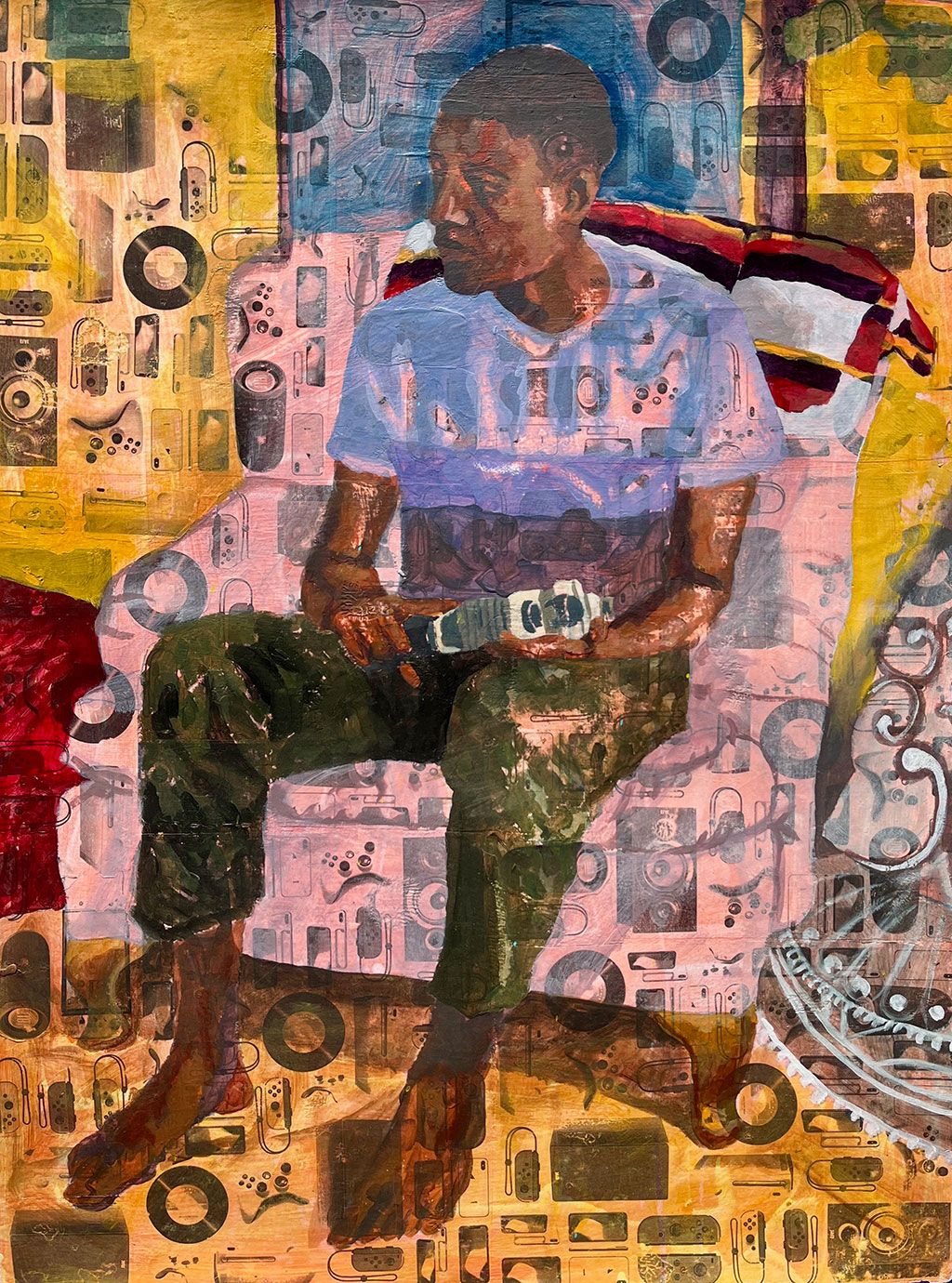
Quinten’s Outrospective, 22.5″ x 30″, acrylic and acrylic gel photo transfer on paper, 2022
Embracing the time-intensive nature of this multilayered process, Kawakami is excited to increase the scale of their projects, so as to create more immersive environments. Some of their largest paintings are currently 51″ x 42″, but they anticipate making diptychs or triptychs that are possibly two or three times the size.
“I think it’s important that… my artwork feels like it’s an enveloping world and that you can walk around in it and see it from different angles,” they explain.
Kawakami has also been pondering how their art can take on a cinematic feeling “where there could potentially be characters … that you recognize.” They have even contemplated writing a narrative to accompany their paintings, as they look for ways to connect the paintings into “a timeline of events” rather than have them exist in “singular [experiences] of a world that doesn’t add up.”
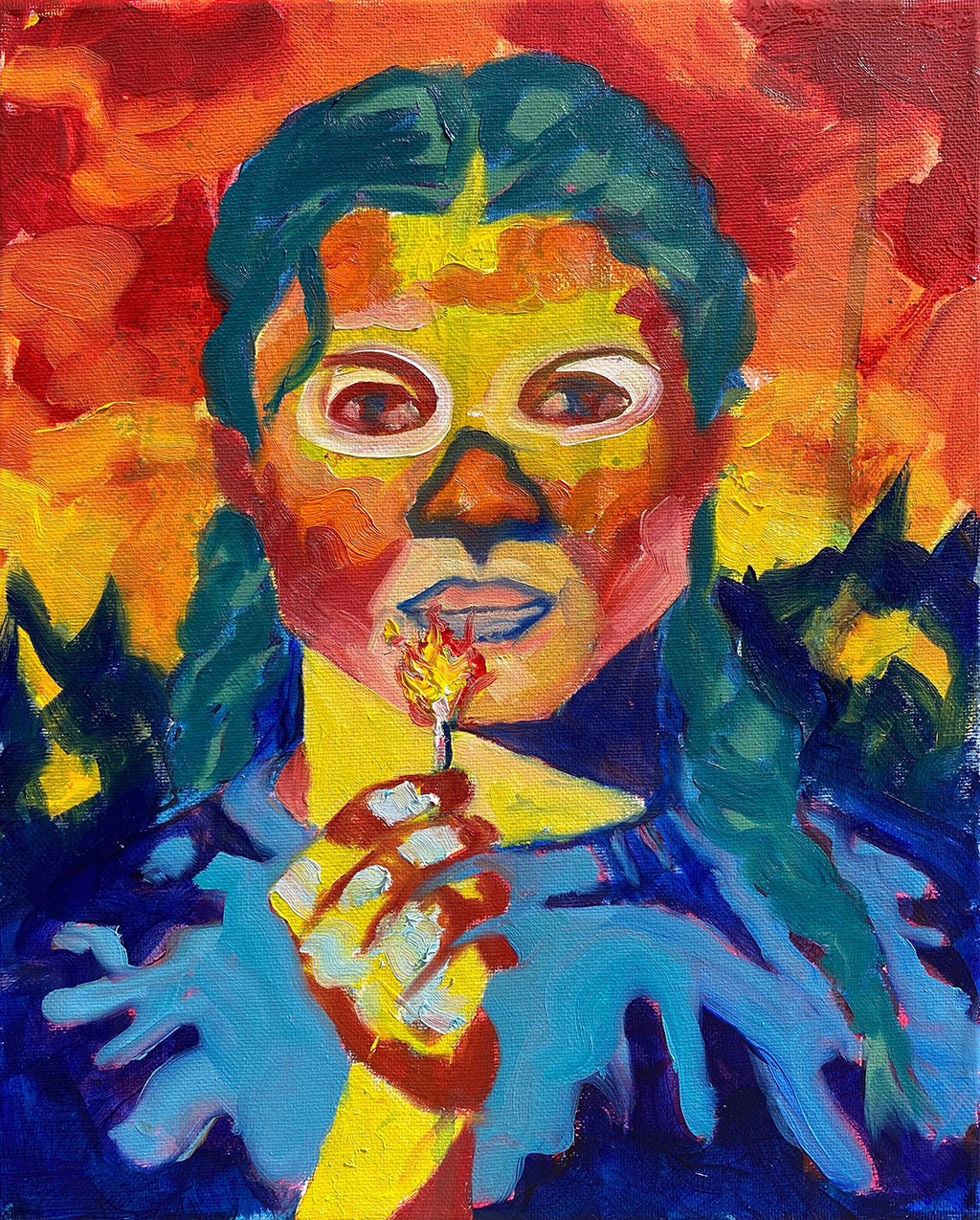
Madeline, 12″ x 10″, oil and acrylic on canvas, 2022
Looking into an Uncertain Future: Who is This For and Why?
Born, raised, and still residing in Washington state, the Pacific Northwest region has been a continuous source of inspiration for Kawakami’s art practice In addition to an innate “sense of wonder” that comes with being in nature and the “childlike sense of appreciation for the world and its natural elements” that they wish to portray in their artwork, Kawakami explains that there is an endless source of inspiration in seeing that – despite climate disasters and overwhelming destruction – “nature will survive.”
Their work has also had a profound and relevant impact on people in their community. Once, when selling prints of their paintings at a tabling event in downtown Bellingham, several people stopped by to share their stories about living through the stressful and uncertain period of the flood.
Such moments of connection are important to Kawakami and have inspired them to continue creating paintings with fragments of familiarity. When they have the resources to do so, Kawakami would like to interview different people and learn about “their experiences with regional climate change in their communities.” They speculate about branching out to different regions of the country and know that conducting interviews would be crucial to creating “accurate depictions of the events” and “the emotions that [the community] was feeling” at that time.
While Kawakami’s art is, of course, open for all to explore, and they take great interest in hearing a great variety of perspectives and reflections from all generations, they believe it is really most cathartic “for the [younger] people who are gonna have to live in this environment for a lot longer.”
“I feel like a lot of people in my circles kind of have a similar outlook on climate change and the apocalypse,” says Kawakami. “It’s really disheartening, but you kind of just have to become numb to it so you can continue functioning in society.”
Yet, Kawakami’s climate-apocalyptic paintings act as containers to process the despair and heartbreak of a changing, destructive world, and to practice hope amongst the chaos. There will eventually be a natural conclusion to this as the focus for the practice, and Kawakami will know intuitively when it’s the right time to do so.
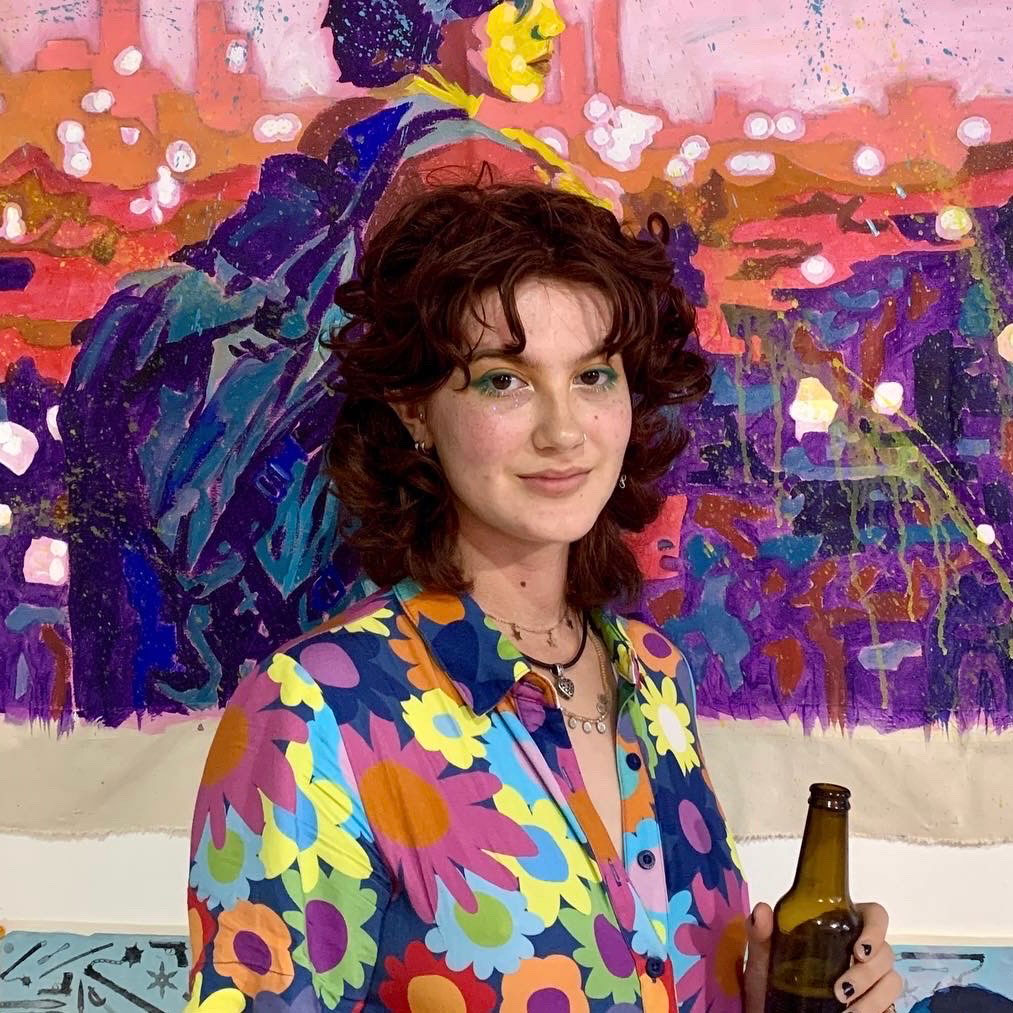
Tesla Kawakami
Ω

